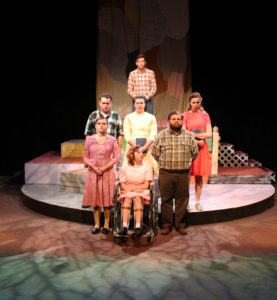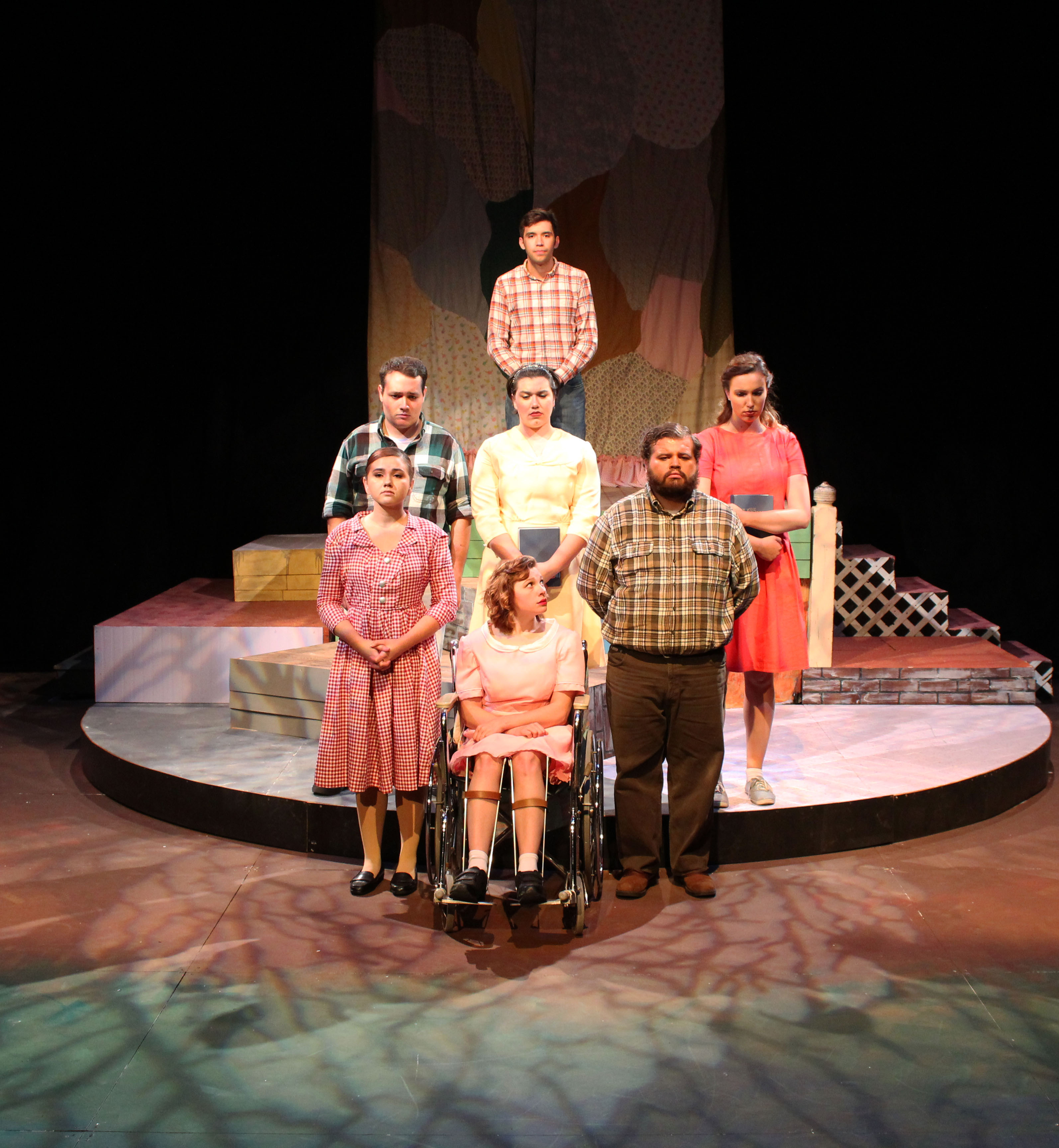“As They Dance Real Slow in Jackson” tells a story of bullying, death and isolation

This photo was taken by Caroline Stuart for the production’s photo call.
As her wheelchair crashed to the stage floor and she drug her body down the steps, the audience of “And They Dance Real Slow in Jackson” watched in horror as Elizabeth Willow made her escape.
The heart-wrenching story of Elizabeth and her family is one of bullying, death and isolation. The show represented an approach to disability that Maryville College’s theatre has not yet portrayed. The show’s premiere had audiences disturbed and touched by Elizzbeth’s story.
“And They Dance Real Slow in Jackson” by Jim Leonard Jr. and directed by Tony Cedeño was presented by the Maryville College Theatre Department the weekend of Nov. 3. Keeping with tradition, the department usually chooses a darker, more thought provoking straight play in the fall.
The show explored Elizabeth’s inability to walk due to polio and the impacts of her disability on her family’s lives in the small town of Jackson, IN. Told non-chronologically through a plethora of changing characters, the play’s dramatic effect was felt through the tense situations and emotional responses of the characters.
“I think the piece is about what it is to be human,” Cedeño said in an MC Connect release. “It is honest about our dreams, the realities we don’t want to face and the fact that love can be selfish, whether we know it or not. It is about unrealized possibilities. Ultimately, the play is about love and acceptance – in aspects both positive and negative.”
The cast was small, but with many different characters represented—challenging the audience to closely pay attention to what was being said and how it was being said. With no props or costume changes to rely on character, the actors did a phenomenal job changing their voice and body movement to depict character.
Senior Sara Deatherage played Elizabeth while seniors Kayla Yother and Trevor York played Beth and Ben Willow, respectively. The official cast of characters featured Lenny Lively and Molly Hamant as First Man and First Woman, and Zach Massey and Allison Parton as Second Man and Second Woman, but these actors effectively portrayed a wide range of characters from the screaming town children, to the gossiping townspeople, to the degrading voices inside Elizabeth’s head.
The play’s title alludes to Elizabeth’s inability to dance but does not give away her disillusional desire to do so. Alone in her room, her voices ridicule her constant sitting by telling her she’s a liar for claiming that she can dance. They mock her. Pacing around her and telling her to get up and prove that she can dance, their voices overlap with each other and cause Elizabeth extreme stress.
Beautifully choreographed, Lively and Hamant began the second act with a ballroom-esque dance, gracing the stage floor beautifully to the sound of folk music. However, in context, the dance was tragic as the audience could only watch on knowing that Elizabeth could never partake in the dance she so longed to be a part of.
The play’s set was colorful and consisted of multilayered platforms designed in different textures one would find in a house. But, like Elizabeth’s mind, they were skewed and uneven, with wallpaper going down the stairs and quilts going up the walls. Similar to her state of mind, Elizabeth’s upper bedroom was isolated from others through high, steep stairs.
The flooring was a beautiful wash of layered red, green and blue extending all the way down to the audience. Designed to be the riverbank on which Jackson rests. The presence of the river was felt throughout the entire play.
Contributing further to Elizabeth’s isolation and state of mind was the lighting. Harsh angles and colorful washes bathed Elizabeth in different settings, sometimes putting in her in a warm environment with friends, other times putting her in a place of hallucination where her only friends were the harsh voices scrutinizing and mocking her.
Overall, the fall production for the theatre department was a success because of the dedication to character from the actors and the fullness that the set brought. The production elements of the show’s design were blended within the theme of the show itself; nothing about music or lighting seemed out of place.
Through spaces in time and place the show moved jumping from character to character and place to place. The show’s elements allowed the audience to move within Elizabeth’s world freely by showcasing a place of hurt and a yearning for acceptance.

